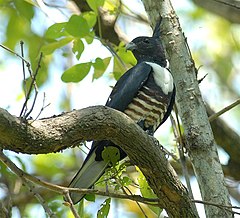Aviceda
Aviceda – rodzaj ptaków z podrodziny orłosępów (Gypaetinae) w rodzinie jastrzębiowatych (Accipitridae).
| Aviceda[1] | |||
| Swainson, 1836[2] | |||
 Przedstawiciel rodzaju – czubak czarny (A. leuphotes) | |||
| Systematyka | |||
| Domena | |||
|---|---|---|---|
| Królestwo | |||
| Typ | |||
| Podtyp | |||
| Gromada | |||
| Podgromada | |||
| Infragromada | |||
| Rząd | |||
| Rodzina | |||
| Podrodzina | |||
| Plemię | |||
| Rodzaj |
Aviceda | ||
| Typ nomenklatoryczny | |||
|
Aviceda cuculoides Swainson, 1836 | |||
| Synonimy | |||
|
| |||
| Gatunki | |||
| |||
Zasięg występowania
edytujRodzaj obejmuje gatunki występujące w Afryce, Azji, Australii i Oceanii[9].
Morfologia
edytujDługość ciała 28–48 cm, rozpiętość skrzydeł 64–117 cm; masa ciała 168–448 g[9].
Systematyka
edytujEtymologia
edytuj- Aviceda (Avicida): łac. avis „ptak”; -cida „zabójca”, od caedere „zabić”[10].
- Baza: hindi Bāz „jastrząb” (nazwa stosowana na określenie samicy jastrzębia zwyczajnego, samiec nazywany jest Jurra)[10]. Gatunek typowy: Baza syama Hodgson, 1837 (= Falco leuphotes C. Dumont, 1820).
- Lepidogenys: gr. λεπις lepis, λεπιδος lepidos „łuska”, od λεπω lepō „obierać, łuszczyć się”; γενυς genus, γενυος genuos „szczęka, policzek, broda”[10]. Gatunek typowy: Lepidogenys subcristatus Gould, 1838.
- Hyptiopus: gr. ὑπτιος huptios „płaski”; πους pous, ποδος podos „stopa”[10]. Nowa, klasyczna nazwa dla Baza Hodgson, 1837.
- Lophastur: gr. λοφος lophos „czub”; rodzaj Astur de Lacépède, 1801, (jastrząb)[10]. Gatunek typowy: Pernis jerdoni Blyth, 1842.
- Nesobaza: gr. νησος nēsos „wyspa” (tj. Madagaskar); rodzaj Baza Hodgson, 1837[10]. Gatunek typowy: Pernis madagascariensis A. Smith, 1834.
Podział systematyczny
edytujDo rodzaju należą następujące gatunki[11]:
- Aviceda cuculoides Swainson, 1837 – czubak afrykański
- Aviceda madagascariensis (A. Smith, 1834) – czubak madagaskarski
- Aviceda jerdoni (Blyth, 1842) – czubak brunatny
- Aviceda subcristata (Gould, 1838) – czubak australijski
- Aviceda leuphotes (C. Dumont, 1820) – czubak czarny
Uwagi
edytuj- ↑ Niepoprawna późniejsza pisownia Aviceda Swainson, 1836.
Przypisy
edytuj- ↑ Aviceda, [w:] Integrated Taxonomic Information System (ang.).
- ↑ W. Swainson: On the natural history and classification of birds. Cz. 1. London: John Taylor, 1836, s. 300. (ang.).
- ↑ B.H. Hodgson. Additions to the Ornithology of Népal. „The Journal of the Asiatic Society of Bengal”. 5, s. 777, 1836. (ang.).
- ↑ J. Gould: A synopsis of the birds of Australia, and the adjacent Islands. London: John Gould, 1838, s. ryc. 9 i tekst. (ang.).
- ↑ H.E. Strickland. Commentary. „The Annals and Magazine of Natural History”. 6, s. 416, 1841. (ang.).
- ↑ B.H. Hodgson. Classical terminology of Natural History. „The Journal of the Asiatic Society of Bengal”. 10 (1), s. 27, 1841. (ang.).
- ↑ E. Blyth. Aves. „The Journal of the Asiatic Society of Bengal”. 11. s. 463. (ang.)..
- ↑ G.M. Mathews: The birds of Australia. Cz. 5. London: Witherby, s. 213. (ang.).
- ↑ a b D.W. Winkler, S.M. Billerman & I.J. Lovette: Hawks, Eagles, and Kites (Accipitridae), version 1.0. W: S.M. Billerman, B.K. Keeney, P.G. Rodewald & T.S. Schulenberg (red.): Birds of the World. Ithaca, NY: Cornell Lab of Ornithology, 2020. DOI: 10.2173/bow.accipi1.01. [dostęp 2020-05-29]. (ang.).
- ↑ a b c d e f Etymologia za: The Key to Scientific Names, J.A. Jobling (red.), [w:] Birds of the World, S.M. Billerman et al. (red.), Cornell Lab of Ornithology, Ithaca (ang.).
- ↑ Systematyka i nazwy polskie za: P. Mielczarek & M. Kuziemko: Plemię: Pernini Blyth, 1851 (Wersja: 2019-03-24). [w:] Kompletna lista ptaków świata [on-line]. Instytut Nauk o Środowisku Uniwersytetu Jagiellońskiego. [dostęp 2019-11-13].